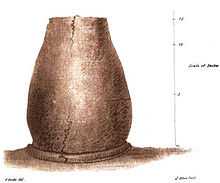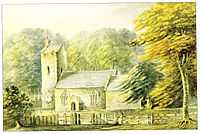John Swete
Rev. John Swete (born John Tripe) (July 1752 – 25 October 1821) of Oxton, Kenton in Devon, was a clergyman, artist, antiquary, historian and topographer and author of the Picturesque Sketches of Devon consisting of twenty illustrated journals of Devonshire scenery.[1]
Biography
John Tripe was born in 1752 in Ashburton, Devon, England. He was the son of the surgeon Nicholas Tripe. He was educated at Ashburton Free School and went to Eton College in 1769 and then later to University College, Oxford. Tripe graduated with a B.A. in 1774 and obtained an M.A. in 1777. In 1775, he became a curate at Highweek, Newton Abbot and in 1776 he was appointed curate at Kenn a few miles south of Exeter. In 1781, he was made a Prebendary of the Diocese of Exeter.[2]
In 1780, by Act of Parliament, John Tripe changed his surname Swete to inherit from Mrs. Esther Swete who was a relative on his father's side.[2] He had already inherited Oxton House on Haldon near Kenton from his father. His inherited wealth enabled him to resign his curacy at Kenn and embark on a series of tours. In April 1873 he set out on a tour of Wales, the Lake District and Scotland. It had been his intention to go on a tour of Europe but instead he met Charlotte Beaumont in Matlock, Derbyshire and they were married in January 1784. They had twelve children of whom four died in infancy.
Picturesque Sketches of Devon
In 1789, Swete set out on the first of his tours of Devon across Dartmoor into North Devon. This was the start of the production of twenty volumes of journals produced up until 1802 which he called Picturesque Sketches of Devon. These were lavishly illustrated with 674 [3] watercolour sketches of the scenery and notable architecture that he encountered on his tours. Swete, usually accompanied by a servant, would travel by horseback and he would take notes and make quick preliminary drawings on the way. After each tour he would spend months at Oxton House producing the final water colour sketches. The journals documented the landscape of Devon and discussed diverse issues from techniques in landscape gardening, industry and mining, archaeology and any curiosities that Swete encountered.
The journals were not published in full during Swete's lifetime but remained in the possession of the family. The sections relating to Torquay were published in the Torquay Directory in 1871 and the Tour Across Dartmoor in to North Devon, the first tour, was finally published in full in 1901 in Devon Notes & Queries.[4] During the Second World War four of the journals were destroyed but the surviving handwritten Illustrated Journals of the Reverend John Swete were donated to the Devon Record Office in 1959. Five of the journals were published in 1984 as part of Peter Hunt's Devon's Age of Elegance.[5] Nearly 200 years after they were originally produced the journals were transcribed and published in full for the first time in 1997 in the four volume Travels in Georgian Devon: The Illustrated Journals of the Reverend John Swete, 1789–1800.[1]
Published works

Swete was a member of the Exeter Literary Society alongside his neighbour the historian Richard Polwhele who had been appointed curate of Kenton in 1782. In 1793 Swete gave a Presidential Address[2] based partially on the first journal, a Tour Across Dartmoor in to North Devon and this was published in three parts in Essays, by a Society of Gentlemen.[6] The first article On some of the more remarkable British Monuments in Devon combined a description of a visit to the Drewsteignton cromlech (Spinsters' Rock), along with an account of the discovery by Swete and his father Nicholas Tripe of prehistoric urns in barrows on Haldon Hill.[7] The same edition contained the articles Of Sepulture in general, and Sepulural Stones erect[8] and On the Valley of the Stones, and the country near Linton.[9]
Swete contributed material used by Polwhele in his Historical Views of Devonshire (1793) and History of Devonshire (1793–1806) and he also gave some literary assistance to editions of Prince's Worthies of Devon (1810) and Risdon's Survey of Devon (1811).[2] Swete contributed three poems to Polwhele's Traditions and Recollections (2 vols, 1826) and seven poetical pieces to Polwhele's Poems, Chiefly by Gentlemen of Devonshire and Cornwall (1792).[10] In addition to contributions to published works Swete wrote several unpublished journals and books including an autobiography and six volumes of poetry.[2] It is estimated that there are nearly 1000 watercolours by Swete in public ownership.[2] These works are held mostly by the Devon Record Office with some in the Exeter Royal Albert Memorial Museum.
Marriage & progeny
In January 1784 he married Charlotte Beaumont, whom he met in Matlock, Derbyshire, and by whom he had twelve children (of whom four died in infancy) including:
- Eliza Swete (1787-1865), who married Revd. Richard Ellicombe and whose mural monument survives in Alphington Church, Near Exeter.[11]
Landholdings
Swete owned estates including:
- Oxton, Kenton, his main residence.
- Poltimore, Farway.[12]
- Whitley, Farway.[12]
Gallery
| Wikimedia Commons has media related to John Swete. |
-

"North East View of Eggesford" dated 1797, watercolour by Rev. John Swete. Devon Record Office ref: 564M/F11/99
-

"Eggesford, Seat of Hon. Newton Fellowes", viewed from NW, watercolour by Rev. John Swete dated 1797. Devon Record Office 564M/F11/111
-

Old Bicton Church, Bicton, Devon, 1795, viewed from south. Watercolour by Rev. John Swete (1752–1821) with caption: "Bicton Church, 31 March 1795". Devon Record Office, 564M/F8/26
-

Heanton Court, Heanton Punchardon, nr Barnstaple, Devon. Painted by Rev. John Swete in 1796, copied by him from a painting by "Mr Payne"
References
- ↑ 1.0 1.1 Published in four volumes as Travels in Georgian Devon: The Illustrated Journals of the Reverend John Swete, 1789–1800, edited by Todd Gray and Margery Rowe (Halsgrove, 1997).
- ↑ 2.0 2.1 2.2 2.3 2.4 2.5 Gray 1997, Todd Gray's Introduction to Travels in Georgian Devon. Vol. 1 includes a detailed biography.
- ↑ "The Western Antiquary Vol.6". The Western Antiquary 6: pp.269–270. 1887. Retrieved 12 March 2012.
- ↑ "A Tour Across Dartmoor in to North Devon". Devon Notes & Queries 1: 88–96,169–175,205–208. 1901. Retrieved 12 March 2012.
- ↑ Journals 1, 8, 10, 14 and 15 published in Hunt, Peter, ed. (1984). Devon's age of elegance: described by the diaries of the Reverend John Swete, Lady Paterson and Miss Mary Cornish. Devon Books. ISBN 0-86114-750-2.
- ↑ "On some of the more remarkable British Monuments in Devon". Essays, by a Society of Gentlemen, at Exeter: 106–130. 1796. Retrieved 12 March 2012.
- ↑ See also Worth, R.N. (1879). "First Report of the Barrow Committee". Transactions of the Devonshire Association 11: pp.151–4. Retrieved 12 March 2012.
- ↑ Essays, by a society of gentlemen, at Exeter (1796), pp. 297–314.
- ↑ Essays, by a society of gentlemen, at Exeter (1796), pp. 479–490.
- ↑ The Western Antiquary (1887).
- ↑
- ↑ 12.0 12.1 Journal, 1795, Gray & Rowe, vol.2, p.107